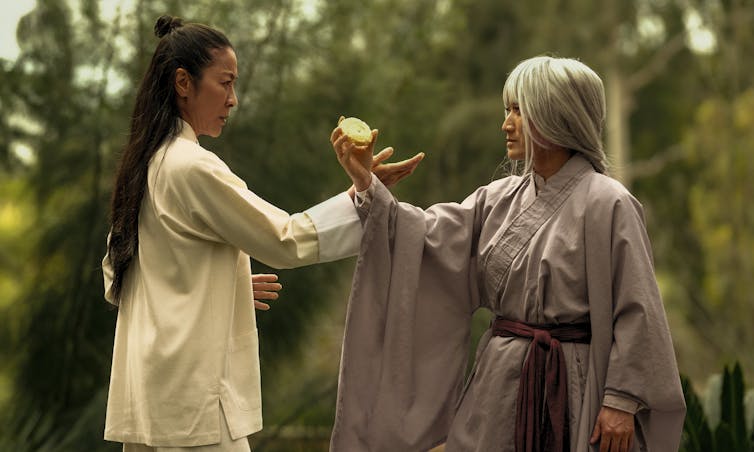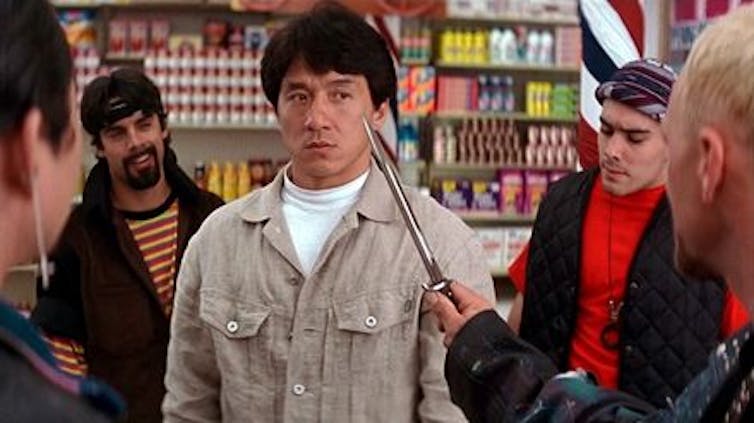Source: The Conversation (Au and NZ) – By Joyleen Christensen, Senior lecturer, University of Newcastle

Everything Everywhere All At Once, a sci-fi action comedy, manages the surprising feat of paying homage to martial arts cinema classics while also delivering a strange and completely fresh, genre-bending film.
Written and directed by Dan Kwan and Daniel Scheinert (collectively known as “the Daniels”), Everything Everywhere All At Once is a delirious adventure blending a heartwarming examination of personal and family crisis with a wild sci-fi storyline, and some of the most amusingly bizarre fight scenes to ever grace the screen.
Taking inspiration Jackie Chan’s kung fu comedies, the film’s fight scenes combine fast, free-flowing martial arts with slapstick humour.
The Daniels have acknowledged the film was originally conceived of as a vehicle for Chan. However, after seizing upon the idea of flipping the gender of its unlikely hero, the directors decided to hand the reins to Michelle Yeoh, who has enjoyed a resurgence in popularity after starring in two recent hits, Crazy Rich Asians and Shang-Chi and the Legend of the Ten Rings.
Into the Michelle Yeohniverse
Although never professionally trained in martial arts, Malaysian-born Yeoh achieved fame in 1990s Hong Kong action films such as Yes, Madam! and Jackie Chan’s Supercop. An ex ballerina, renowned for doing most of her own stunts, Yeoh typically relies on on-set fight training for her action scenes.
In Everything Everywhere All At Once, this meant Yeoh was teaming with brothers Andy and Brian Le for the most outlandish fight of her career – a scene where Yeoh’s character must fight a pair of butt plug-armed henchmen.
The self-taught Le brothers drew Hollywood’s attention via the popular Martial Club YouTube channel where, along with friend Daniel Mah, the brothers recreated fight scenes from classic Hong Kong kung fu films.
Working with stunt coordinator, Timothy Eulich, to choreograph a number of Everything Everywhere All At Once’s fight scenes, the Le brother’s encyclopaedic knowledge of kung fu cinema is credited by Eulich as helping shape the film’s approach to action.
Everything Everywhere All At Once
Caught up in shattering disappointment over what her life has become, laundromat owner Evelyn Wang (Yeoh) gets a welcome reprieve from her drab reality when she is drawn into a cosmic battle and given the ability to travel through the multiverse.
Skipping between alternate lives she could have led, Evelyn draws upon the memories and skills of her other selves, including a Teppanyaki chef and an opera singer. In a nice nod to Yeoh’s own position as a globally-recognised star of films such as Crouching Tiger, Hidden Dragon, one of Evelyn’s most significant alternate selves is a famous, martial arts-trained actress.

AAP
Evelyn discovers she is the multiverse’s only chance at salvation and, as various evil beings hunt her and her family, she is forced to engage in frequent battles, using whatever objects are close at hand as weapons.
À lire aussi :
From Bruce Lee to Shang-Chi: a short history of the kung fu film in cinema
Everything is a weapon
The combination of an unlikely hero being forced to fight – typically with impromptu weapons – before revealing a startling degree of martial arts proficiency is the key ingredient of numerous Jackie Chan action comedies, especially those made for English-speaking audiences after Chan relocated to the USA in the 1990s.
Drawing inspiration from Buster Keaton’s silent-era physical comedies, Chan’s films eschew traditional action genre rules. The most obvious divergence is that Chan’s characters rarely enter a fight armed with anything other than natural ability. Chan forsakes outright hostility for demonstrations of acrobatic martial skill combined with humour.

IMDB
Each set of Chan’s iconic fight scenes are filled with a suite of potential weapons. For example, Chan’s confrontation with a gang of punks in Rumble In The Bronx, starts with Chan on a pool table. The actor uses everything from a fridge, to a television, a set of speakers, a shopping trolley and even a pinball machine, as weapons.
In The Spy Next Door, Chan is trapped in a kitchen and, after first slamming a fridge door into a thug, Chan repeatedly beats the man over the head with pots and pans. Though it sounds violent, the tone of the scene is more Looney Tunes than Dirty Harry.
Everything old is new again
The scene is a homage to the 1976 Hong Kong Hui Brothers’ comedy, The Private Eyes. In the original film, an inept private eye finds himself battling a villain in the kitchen of a restaurant. The ridiculous nature of the fight escalates as the opponents move from pans and colanders to a gourd-slicing swordfish, a shark jaw, a sausage nunchuck, and a wok that is tossed like a boomerang.

IMDB
Everything Everywhere All At Once features a similar throwback to that iconic scene – this time swapping the sausages for dildos to make a pair of impromptu tonfa batons. Another standout scene features Evelyn’s husband, Waymond (Ke Huy Quan) expertly wielding a fanny pack to take down an entire group of thugs.
Everything Everywhere All At Once is a fresh addition to the comedy martial arts canon.
Despite the existential premise of the film – and the surprising depth of the relationship dramas – the execution of action is skilful. More significantly, the action doesn’t take itself seriously and the humour doesn’t stop when the action starts.
![]()
Joyleen Christensen ne travaille pas, ne conseille pas, ne possède pas de parts, ne reçoit pas de fonds d’une organisation qui pourrait tirer profit de cet article, et n’a déclaré aucune autre affiliation que son organisme de recherche.
– ref. How Everything Everywhere All At Once fits into the canon of comedy-martial arts films – https://theconversation.com/how-everything-everywhere-all-at-once-fits-into-the-canon-of-comedy-martial-arts-films-181480








